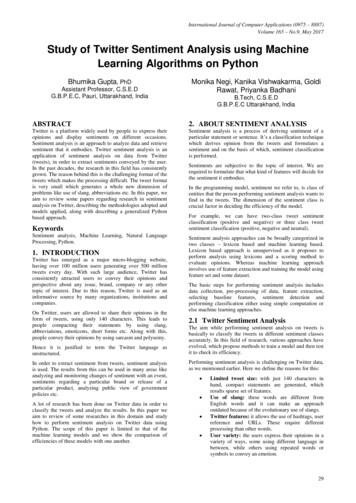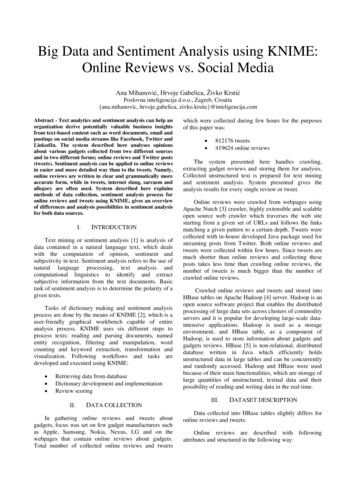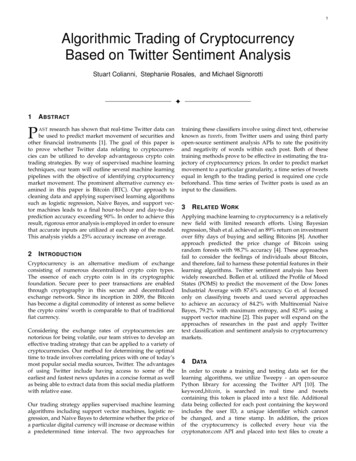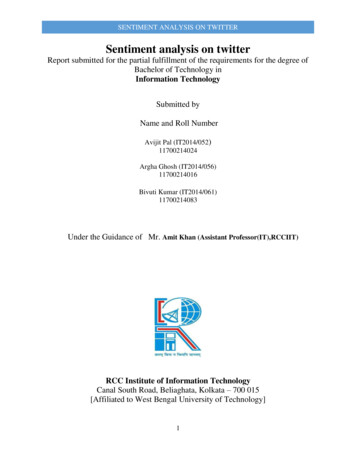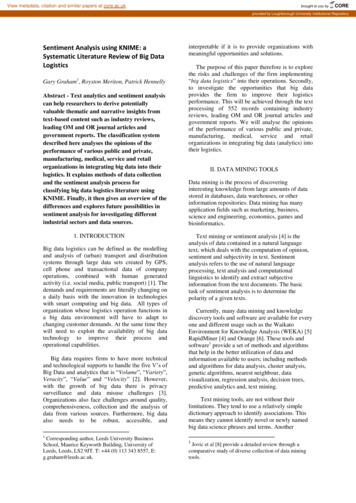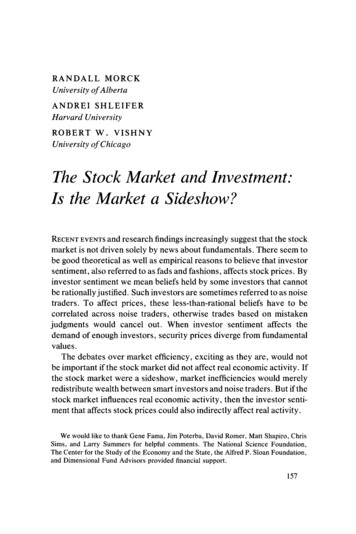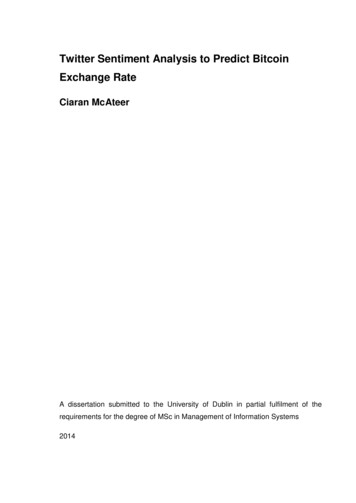
Transcription
Twitter Sentiment Analysis to Predict BitcoinExchange RateCiaran McAteerA dissertation submitted to the University of Dublin in partial fulfilment of therequirements for the degree of MSc in Management of Information Systems2014
DeclarationI declare that the work described in this dissertation is, except where otherwise stated,entirely my own work, and has not been submitted as an exercise for a degree at this orany other university. I further declare that this research has been carried out in fullcompliance with the ethical research requirements of the School of Computer Science andStatistics.Signed:Date:Ciaran McAteerSept 2014ii
Permission to Lend or CopyI agree that the School of Computer Science and Statistics, Trinity College Dublin maylend or copy this dissertation upon request.Signed:Date:Ciaran McAteerSept 2014iii
AcknowledgementsI would like to thank my supervisor Susan Leavy for her support and advice throughoutthis dissertation.Thanks also to the lecturers and staff of Trintiy College Dublin.And finally to my wife Muireann and sons Manus, Conall and Senan for their ongoingsupport.iv
AbstractThe microblogging platform Twitter has become a valuable source of user sentiment. Thispaper presents an evaluation of Twitter sentiment as a useful metric for predictingfinancial markets, specifically the bitcoin exchange rate. The tweets associated with thebitcoin digital currency are tracked in order to determine if the user sentiment containedwithin those tweets reflects the exchange rate of the currency. The sentiment of users’tweets is categorised as having a positive, negative or neutral opinion of the virtualcurrency using machine learning techniques. Time series analysis is performed whichreveals that there is a positive correlation between the Twitter sentiment and the bitcoinexchange rate, and that sentiment is reflected in price after a time delay of 24 hours.Other aspects of Twitter, such as volume of tweets related to the subject, and a separateanalysis of retweets, also observe a relationship to the bitcoin digital currency.v
Table of Contents1 Introduction . 11.1 Introduction . 11.2 Research Background . 11.3 Research Question . 41.4 Research Scope . 51.5 Importance of this Research and Beneficiaries . 61.6 Guide to Dissertation . 72 Literature Review . 82.1 Introduction . 82.2 How Sentiment Relates to Market Prices . 82.3 How to Measure Sentiment . 102.4 Empirical Evidence – Is Sentiment a Factor? . 122.5 Using Online Data . 142.6 Public Sentiment and Trading . 162.7 Twitter and Trades . 172.8 Bitcoin as an Investment affected by Sentiment . 192.9 Conclusion . 223 Methodology and Fieldwork . 233.1 Introduction . 233.2 Research Philosophy . 233.3 Research Approach . 253.4 Research Strategy . 253.5 Research Choices . 263.6 Research Time Horizons . 263.7 Research Data Collection and analysis . 263.8 Population & Samples. 273.9 Twitter Data Capture – Building the Model . 283.10 Classifying Tweets . 303.11 Twitter Data Capture – Live Data Capture . 31vi
3.12 Bitcoin Price data . 323.13 How Sentiment is Measured . 333.14 Missing Data . 343.15 Conclusion . 344 Findings and Analysis . 354.1 Findings and Analysis Introduction. 354.2 Twitter Message Volume. 364.3 Sentiment of Tweets as a Predictor . 414.4 The Power of Retweets . 484.5 Confirming Correlation with Lag Applied . 515 Conclusions and Future Work . 565.1 Introduction . 565.2 Conclusions . 565.3 Limitations . 585.4 Opportunities for Future Research . 59References . 61Appendix . 65Appendix A – Introduction . 65Appendix B – Methodology and Fieldwork . 66Appendix C – Findings and Analysis . 71vii
TABLESTABLE 3.1 Comparison of four research philosophies (Saunders, 2012) . 24TABLE 3.2 Sample of Training Data . 29TABLE 3.3 Summary of Machine Learning Algorithms in Mahout . 30TABLE 4.1 Correlation of Bitcoin transaction volume and Bitcoin price fluctuation for theyear from July 1st 2013 to June 30th 2014 . 36TABLE 4.2 Number of Tweets, Transaction Volume and Price Fluctuation Correlations . 38TABLE 4.3 Sunday Twitter volumes and number of bitcoin transactions with pricefluctuation . 39TABLE 4.4 Weekend Twitter volumes, transaction volumes and price fluctuationcorrelations . 39TABLE 4.5 Bitcoin prices changes over 21 day period . 41TABLE 4.6 Twitter sentiment for each day in the time period. . 42TABLE 4.7 Strongest cross correlation . 45TABLE 4.8 Cross Correlation of Bullishness value and bitcoin price change over the 24hour time frame . 46TABLE 4.9 Strongest correlation for 8 hour time frame . 47TABLE 4.10 Cross Correlation scores for 8 hour and 24 hour periods . 48Table 4.11 Number of tweets and retweets in data set. . 49TABLE 4.12 Cross correlation results of retweets only and no retweets 24 hour period . 49TABLE 4.13 Cross correlation results of retweets only and no retweets 8 hour period . 50TABLE 4.14 Correlation of Bullishness and Bitcoin price for 8 hour aggregate with lag of 3applied . 53TABLE 4.15 Correlation results of sentiment and retweets only for 24 hour period . 54FIGURESFIGURE 2.1 Cross-sectional effects of investor sentiment. . 13FIGURE 3.1 Research Onion . 23FIGURE 4.1 Bitcoin exchange price over 21 day period . 35FIGURE 4.2 Natural log of daily volume of tweets and bitcoin transaction volumes. 37FIGURE 4.3 Daily Bitcoin Sentiment from Twitter as produced be automatic classificationof Tweets . 43FIGURE 4.4 Bitcoin daily price change. 44FIGURE 4.5 Cross correlation of Twitter Sentiment aggregated for 24 hours to Bitcoinprice change in 24 hour period . 45viii
FIGURE 4.6 Cross correlation of Twitter Sentiment aggregated for each 8 hours to Bitcoinprice change for each 8 hours . 45FIGURE 4.7 Cross correlation of Twitter bullishness for each 8 hours to Bitcoin pricechange for a day . 47FIGURE 4.8 Bitcoin Price Change intervals of 8 hours . 52FIGURE 4.9 Bullishness value aggregated over 8 hour period . 52FIGURE 4.10 Bitcoin Price Change intervals of 24 hours . 53FIGURE 4.11 Aggregate sentiment of retweets intervals of 24 hours . 54ix
Twitter Sentiment Analysis to Predict Bitcoin Exchange RateSept 2014Page 11 Introduction1.1 IntroductionThe purpose of this chapter is to provide background information related to the researchquestion selected for this paper. The research topic is introduced, as are the mainresearch question and sub-questions. This chapter also provides background on the topicand the reasons why this research question was selected. The scope of the research, itsimportance and the beneficiaries are discussed.1.2 Research BackgroundSentiment can be defined in its simplest terms as “a view or opinion that is held orexpressed” (OxfordEnglishDictionary, 2014). In terms of financial markets, sentiment canbe viewed as being positive (bullish), negative (bearish) or neutral about a certaininvestment (Brown and Cliff, 2004). Harvesting sentiment has long been used as amechanism for predicting economic trends, surveys of sentiment such as the ConsumerSentiment Index and Purchasing Managers’ Index being two examples of this. With theadvent of the information age the ability to identify and categorise this sentiment hasbecome increasingly important for businesses and researchers alike. Businesses want toknow consumer opinions about their products and services (Liu, 2012). Potentialcustomers want to know the opinions of existing users before they purchase a product(Pang and Lee, 2008). As the information posted by users online covers a broad set oftopics, researchers can use online sentiment not only in field of computer science but alsoin the fields of social sciences and management sciences (Liu, 2012). Advances inmachine learning and processing power allow computers to perform analysis of thissentiment in real time and on a very large scale.The term sentiment analysis (or opinion mining) broadly refers to the computationaltreatment of sentiment, opinion and subjectivity from text (Pang and Lee, 2008). Thispaper uses the technique of classification to categorise Twitter messages according totheir sentiment. Classification is the task of identifying which category a value belongs to.In the context of text classification it means labelling natural language texts withcategories from a predefined set (Sebastiani, 2002). Classification is a type of supervisedlearning, that is, correctly categorised items of text are made available to train theclassifier. Researchers can take advantage of sites that provide ratings along withcustomer reviews to build corpuses of automatically categorised data from sites such asAmazon and Rotten Tomatoes in order create this training data (Pang and Lee, 2008).
Twitter Sentiment Analysis to Predict Bitcoin Exchange RateSept 2014Page 2There are many different sources of sentiment online including websites, blogs, and socialnetworking sites like Facebook and Twitter. The use of natural language processing, textanalysis and computational linguistics enables computers to identify subjective humancommunication and classify it. This practice is common place amongst largeorganisations, with many software providers (such as IBM and SAS) now offeringsolutions to allow corporate customers to perform analysis of customers’ views in relationto their brand or product. Social networking sites offer opportunities as a new source ofinformation to harvest user sentiment in real time and on a much larger scale than waspreviously possible. The volumes of data being produced by social networking sites on adaily basis far exceeds what would be practical with human users classifying this data.Thus the explosion of use of social networking sites has seen a parallel explosion inresearch using sentiment analysis (Liu, 2012). Pang and Lee (2008) suggest that 2001was the year that research into sentiment analysis became widespread, as researchersbecame aware of the opportunities of online data, and that it has been increasing since.Twitter recently announced the results of their ‘Twitter Data Grant’, an initiative to allowresearchers access to the full Twitter live and historical data set. They received 1,300proposals from research institutions, finally selecting 6 institutions to be allocated accessto the data (Twitter, 2014b). The 6 research proposals cover health care (2), sportsscience, disaster and flood analysis (2) and human happiness. The fact that the areasbeing researched are so diverse is an indication of the information that can be extractedfrom these sites both directly, in the form of user’s own opinion and thoughts, andindirectly in the form of who follows whom and what they retweet. Previously researchershave used Twitter as a source of sentiment and opinion across multiple topics: finance(Bollen et al., 2011, Sprenger et al., 2013), politics (Conover et al., 2011, Wang et al.,2012), and geopolitical topics (Huang, 2011, Howard et al., 2011). Users of services likeTwitter speak openly about how they feel about the brands, products or services they use.The opinions spread quickly through the network magnifying the word of mouth effect(Hennig-Thurau et al., 2012). In one sense social networking sites like Twitter andFacebook have become a huge pool of consumer sentiment and public opinion (Pak andParoubek, 2010).1.2.1 Bitcoin – A currency for a digital ageBitcoin originated from a white paper (Nakamoto, 2008) and subsequent open sourcesoftware implementation from a person going by the name Satoshi Nakamoto. The realidentity of Satoshi Nakamoto is unknown. Whether or not this name is the pseudonym ofan individual or a group is also unknown. His involvement with the project ended in 20102
Twitter Sentiment Analysis to Predict Bitcoin Exchange RateSept 2014Page 3but the bitcoin community has grown with many developers contributing to it (bitcoin.org,2014). It is the first example of a crypto-currency (a digital currency that usescryptography to control its creation and transactions) and provides decentralised peer-topeer financial transactions without going through a financial institution.Bitcoin is an implementation of a crypto-currency based on the concept described by thecryptographer Wei Dai in 1998. One of the main problems with a digital currency is theconcept of double spending - if the currency unit can be represented as a text in a file (asopposed to physical paper or coin), then what stops the holder of the currency spending itmultiple times. The conventional answer to this problem was to have a central ledger totrack all transactions, and a trusted central authority to administer it. The Satoshi solutionwas to remove the dependency on a central authority and publicly distribute the ledger, inwhat is known as the ‘block chain’. This makes Bitcoin a distributed and peer-to-peerdigital currency with no one point of failure, or point of weakness, for attack. Despite this,there have been numerous attacks on the surrounding ecosystem that have rocked thebitcoin community. Particularly the rumoured hack of the largest exchange Mt Gox inFebruary 2014, when the exchange lost bitcoin to the value of 409 million US dollars andwent bankrupt (Forbes, 2014).New bitcoins can only be created through a process known as ‘mining’. Miners run adedicated piece of software to try to solve a puzzle. When a puzzle is solved, a new blockis added to the block chain. All miners are notified that a new block has been found andthe process starts over trying to solve a new puzzle to add another block to the chain.Miners typically use dedicated hardware (in the form of specially designed integratedcircuits) to solve the puzzles. The difficulty of each puzzle increases as the number ofminers (or mining power) on the network increases, the difficulty factor of the puzzle iscalculated every 2016 blocks and is based upon the time taken to generate the previous2016 blocks. This keeps production at a steady rate and currently one block is minedroughly every 10 minutes. In addition, the size of each block reward given to the minerthat discovers it is halved every 210,000 blocks - first from 50 bitcoins to 25 (as ofNovember 2012 it is now 25 bitcoins reward), then from 25 to 12.5, and so on. Bitcoin isdesigned to be finite, with a limit of 21 million bitcoins, this is expected to be reached bythe year 2140. In this way bitcoin is more similar to gold than a fiat1 currency where agovernment can decide to print new money, as recently occurred in the rounds of1fiat currency is being used in this context as a government backed currency not linked to acommodity such as gold, as all of the main currencies such as the US dollar are.3
Twitter Sentiment Analysis to Predict Bitcoin Exchange RateSept 2014Page 4quantitative easing undertaken by the central banks of Japan, US and UK in response tothe recession brought about by the financial crisis.Although the technical workings of Bitcoin are complicated and beyond the scope of thispaper, using it to actually purchase products is straightforward, once a supplier supports itas a payment method. It is becoming more commonly used and has been receivingwidespread media coverage in the last number of years. More and more retailers areaccepting it as payment. Virgin Galactic now accepts bitcoin as payment for theircommercial space flights (Galactic, 2013). Expedia has recently become the largest onlinebrand to accept payment in bitcoin. The currency has garnered much attention as apotential alternative to traditional fiat currencies. Forbes recently published a bookdetailing the efforts of their online editor to live for a week on bitcoin (Hill, 2014). Since itsinception bitcoin has been associated with the purchase of illegal substances on sitessuch as Silk Road, an online marketplace operated as a Tor hidden service (sometimescalled the eBay for drugs (Barratt, 2012)), primarily due to its anonymous nature. Whenthe FBI closed the Silk Road site, the bitcoin exchange rate dropped dramatically, only torecover its price again in the weeks that followed. The currency has achieved much morewidespread adoption in the last 2 years. Its use is growing with regular businesses nowaccepting it and with dedicated ATMs in place in a number of countries (BitcoinATMMap,2014). There are also now a number of hedge funds that trade in bitcoin with new fundsappearing all the time (Newsweek, 2014).1.3 Research QuestionThis paper asks the research question (RQ):(RQ1) Can the sentiment on Twitter predict bitcoin exchange rate?Sub questions that are relevant within this research are:(RQ2) Does the volume of Twitter messages relate to bitcoin price movement?(RQ3) Does sentiment merely reflect bitcoin price movements or cause them?(RQ4) Are retweets a better gauge of sentiment and are they more closely linked tobitcoin price changes?4
Twitter Sentiment Analysis to Predict Bitcoin Exchange RateSept 2014Page 51.4 Research ScopeThis work focuses exclusively on Twitter. Twitter is a microblogging platform that allowsusers to post their thoughts and opinions to a public forum in the form of 140 charactermessages known as ‘tweets’. These tweets are publicly accessible and can be searchedfor or followed in real time. Twitter has 255 million monthly users, over 500 million tweetsare sent a day (Twitter, 2014a). The Twitter platform has been shown to offer uniqueinsight into consumer opinion and sentiment (Pak and Paroubek, 2010). The open andhonest nature of the users’ messages, or ‘tweets’, offers an immediate view on theiropinions, likes and dislikes. Consumer sentiment, either on an individual basis oraggregated across a user group, can be extracted from these tweets using specific toolsand techniques. This information has been shown to be as accurate as traditional modelsof capturing user sentiment such as surveys. One such study has shown the use of usertweets to predict election results (Tumasjan et al., 2010). As well as offering a forum forexpressing opinions, many users use Twitter to keep track of information or to follow otherusers. Up to 40% of users merely follow others (News, 2013). Users can also ‘retweet’,which is essentially forwarding someone else’s message to their followers. This results indata being disseminated very quickly across the twitter network. In this way Twitter hasbecome similar to a news network or instant bulletin board, with research showing that85% of the topics that are trending on Twitter are related to current news events (Kwak etal., 2010). Recent events such as the Arab Spring have illustrated the wide reach ofTwitter and its importance in spreading information and shaping popular opinion. Severalstudies have shown the prominent role of Twitter in the Arab Spring (Howard et al., 2011,Khondker, 2011, Lotan et al., 2011, Huang, 2011).1.4.1 Why bitcoin and not some other Forex?The global foreign exchange trading market (or Forex) is not a market that receivesexposure outside of financial institutions. The market for currency trading is enormous anddwarfs all other financial markets, for example the stock exchange. The foreign exchangemarket is on average 5.3 trillion worth of trades a day (GRAHAM, 2014). Thetransactions are between banks and have a low profit margin but, given the size of themarket, offer an enormous reward. Several banks in Switzerland, the UK and the US arecurrently under investigation for the illegal fixing of exchange rates. As this market isessentially controlled by large institutions, there is little to be gained by analysing publiclyavailable sentiment in relation to established currencies.Since its inception, and particularly since it has seen a large increase in value, bitcoin isoften viewed as a speculative investment and is actively traded (Yermack, 2013) Bitcoin5
Twitter Sentiment Analysis to Predict Bitcoin Exchange RateSept 2014Page 6was selected for this research as it offers the potential for a more democratic tradingplatform. Its users are actively engaged with its success and hence are more likely topublicly state their opinions and share information on a service like Twitter. Twitter can beseen as being analogous to the Bloomberg terminals in this context. Whereas theBloomberg terminals are used by traders to get the latest financial information and toexchange information with other traders for a price that is prohibitive for most users,Twitter can be used for free. Bitcoin users and traders can express their opinions andfeelings on the currency on a public platform. Bitcoin users by definition will tend to betechnology savvy and hence are more likely to be active users of Twitter. These userscould be either active tweeters or users that simply follow the topic to view other users’tweets on the subject. As stated previously, Twitter is often used to follow news events,and bitcoin users can use Twitter to keep up to date with the latest bitcoin news andexchange rates. This information is regularly tweeted from the official Twitter accounts forthe various exchange platforms.Another reason for selecting the bitcoin exchange rate is that it is difficult to assign afundamental value to it (Gomez et al., 2014), its value is subjective and should be moreprone to the influence of sentiment on its investors2 (support for this statement will beshown in the literature review). Thus sentiment should correlate to price movements.1.5 Importance of this Research and BeneficiariesWhen it comes to financial markets, there are distinct advantages in harnessing thispublicly available data over a traditional method like an investor survey. Firstly, the scaleis well beyond what can be done through traditional methods, and secondly, the data canbe captured in near real time. In the modern financial market this second factor is crucial.The Purchasing Managers Index takes weeks to collect; by the time the survey results areavailable the data may be stale or rendered irrelevant by socio-political changes. Giventhe real time nature of Twitter, it offers the ideal source of public data. Companies likeStockTwits.com have formed by providing this information in a convenient manner, andTwitter introduced the concept of ‘cashtags’ (for example APPL) to allow users tospecifically track stock symbols they are interested in.This research will be of benefit to both those interested in the field of sentiment analysis ofonline data and those with an interest in the bitcoin digital currency. This paper builds on2in this context investors can be seen as users of the currency, as they have invested in its futureby purchasing it6
Twitter Sentiment Analysis to Predict Bitcoin Exchange RateSept 2014Page 7many research activities in recent years that show that sentiment can be used as apredictor for financial markets.1.6 Guide to DissertationThe structure of this dissertation is divided into the following chapters.Chapter 1: Introduction – This chapter outlines the context, rationale and background tothe research question.Chapter 2: Literature Review – This chapter reviews the history of sentiment research withfinancial markets, moving to later day sentiment analysis of online data. The literaturereview shows why the research question was selected.Chapter 3: Methodology and Fieldwork – This chapter explores the methodologiesconsidered for this research and the reason for choosing the selected methodology.Details are given of how the research was carried out, the data collected and analysed.Chapter 4: Findings and Analysis – This chapter states the findings of the research andanalyses and reflects on these findings.Chapter 5: Conclusions and Future Work – This chapter will show if the research hasanswered the research query, found any new or interesting results, and indicate anypossible future research in that could come from this work.7
Twitter Sentiment Analysis to Predict Bitcoin Exchange RateSept 2014P
Twitter Sentiment Analysis to Predict Bitcoin Exchange Rate Ciaran McAteer A dissertation submitted to the University of Dublin in partial fulfilment of the requirements for the degree of MSc in Management of Information Systems . TABLE 4.1 Correlation of Bitcoin transaction volume and Bitcoin price fluctuation for the year from July 1st 2013 .
